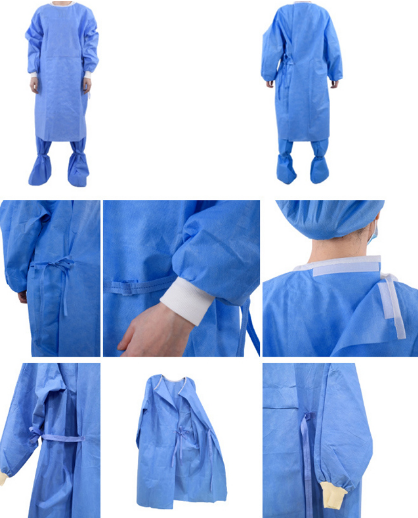- Automobiles & Motorcycles
- Beauty & Personal Care
- Business Services
- Chemicals
- Construction & Real Estate
- Consumer Electronics
- Electrical Equipment & Supplies
- Electronic Components & Supplies
- Energy
- Environment
- Excess Inventory
- Fashion Accessories
- Food & Beverage
- Furniture
- Gifts & Crafts
- Hardware
- Health & Medical
- Home & Garden
- Home Appliances
- Lights & Lighting
- Luggage, Bags & Cases
- Machinery
- Measurement & Analysis Instruments
- Mechanical Parts & Fabrication Services
- Minerals & Metallurgy
- Office & School Supplies
- Packaging & Printing
- Rubber & Plastics
- Security & Protection
- Service Equipment
- Shoes & Accessories
- Sports & Entertainment
- Telecommunications
- Textiles & Leather Products
- Timepieces, Jewelry, Eyewear
- Tools
- Toys & Hobbies
- Transportation
What is the difference between Disposable isolation gown and surgical gown?
In the realm of medical apparel, two essential pieces of clothing play a crucial role in maintaining hygiene and ensuring the safety of both healthcare professionals and patients: disposable isolation gowns and surgical gowns. While they may appear similar at first glance, these garments serve distinct purposes and are designed to meet specific requirements in medical settings. In this comprehensive guide, we will delve into the intricate details of both disposable isolation gowns and surgical gowns, highlighting their disparities, purposes, and the critical factors that set them apart.

Disposable Isolation Gown: A Shield of Protection
Material and Construction
Disposable medical isolation gowns are primarily crafted from non-woven materials such as polypropylene, polyethylene, or spunbond-meltblown-spunbond (SMS) fabric. These materials are chosen for their durability, fluid resistance, and breathability. The gowns are single-use, and their construction includes long sleeves, a front opening, and a tie-back closure, ensuring complete coverage of the wearer's body.
Purpose and Usage
The primary purpose of disposable isolation gowns is to provide a barrier against potentially infectious materials and bodily fluids. Healthcare professionals commonly wear them during routine patient care activities, like examining patients, administering medications, or performing minor procedures that do not involve extensive fluid exposure. These gowns are designed to be discarded after each use, reducing the risk of cross-contamination.
Key Features
Fluid Resistance: Disposable isolation gowns are engineered to repel liquids, safeguarding the wearer from contact with contaminants.
Comfort: Their lightweight and breathable design ensures comfort during prolonged wear, minimizing heat stress.
Cost-Efficiency: Being disposable, these gowns eliminate the need for laundering and sterilization, reducing operational costs.
Surgical Gown: Precision in the Operating Room
Material and Construction
Surgical gowns, on the other hand, are specifically tailored for use in sterile environments like operating rooms. They are typically made from tightly woven cotton or a blend of polyester and cotton, ensuring a high level of sterility. These gowns feature long sleeves and a wrap-around design, with closures at the back or front.
Further reading:Surgical Hand Brush: A Crucial Tool for Proper Surgical Hand Hygiene
KN95 Mask: An Essential Tool for Protection Against Airborne Contaminants
The Versatility and Benefits of Medical Bedside Cabinets
Long Cuff Nitrile Gloves: Superior Protection and Extended Coverage
All Things About Hydrophilic Non-woven Fabrics
Disposable Hemoclips vs. Traditional Methods: A Revolution in Bleeding Control
Gynae Instruments,Gynecology Instruments
Purpose and Usage
Surgical gowns are a critical component of a surgeon's attire and serve the primary purpose of maintaining an aseptic environment during surgical procedures. Unlike disposable isolation gowns, surgical gowns are reusable and undergo strict sterilization processes, including autoclaving, to ensure they are free from microorganisms.
Key Features
Sterility: Surgical gowns are meticulously sterilized to prevent contamination in the operating room, minimizing the risk of surgical site infections.
Durability: These gowns are built to withstand multiple rounds of sterilization and provide long-lasting protection.
Customizability: Surgical gowns come in various sizes and styles to accommodate the diverse needs of surgical teams.
Key Differences: Disposable Isolation Gown vs. Surgical Gown
1. Purpose
Disposable isolation gowns are primarily intended to protect against contaminants and are disposed of after single use, while surgical gowns are designed to maintain sterility in surgical settings and can be reused.
2. Material
Disposable isolation gowns use non-woven materials for comfort and fluid resistance, whereas surgical gowns are crafted from tightly woven fabrics to ensure sterility.
3. Construction
Disposable isolation gowns typically feature a tie-back closure and front opening, whereas surgical gowns have wrap-around designs with various closure options.
Conclusion
In the medical world, understanding the fundamental differences between disposable isolation gowns and surgical gowns is paramount. Both serve critical roles in maintaining safety and hygiene, but they are tailored to specific medical scenarios. While Disposable Protective Clothing offer cost-effective protection against contaminants in non-sterile environments, surgical gowns are the guardians of sterility in the operating room.
Further reading:Do cellulose sponges work?
Choosing the Right Prosthetic Foot: Factors to Consider
How do you use oral swab sticks?
What are the benefits of using disposable shoe covers in healthcare settings?
What are Types of Lower Limb Prosthesis?
Is There A Difference between Isolation Gown And Coverall?
Unveiling the Distinctions: TPU Film vs. PU Film
If you are interested in sending in a Guest Blogger Submission,welcome to write for us!




Comments
0